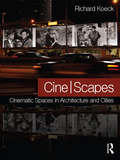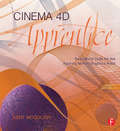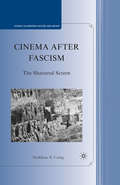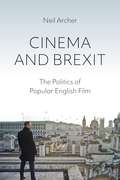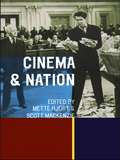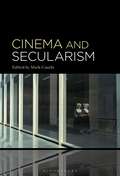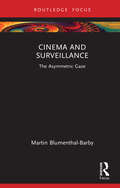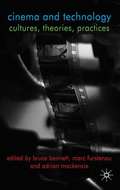- Table View
- List View
Cine-scapes: Cinematic Spaces in Architecture and Cities
by Richard KoeckCine-scapes explores the relationship between urban space, architecture and the moving image. While an impressive amount of research has been done with regards to the way in which architecture is portrayed in film, this book offers a new perspective.... What happens if we begin to see the city as a place for an embodied visual consumption; a visual apparatus or, perhaps, a system that is based on movement, light and the body, and which we can explore in kinematic, kinetic, and kinaesthetic ways? Using film as a lens through which we look at urban spaces and places, Richard Koeck reveals the filmic and cinematic phenomena and spatial qualities that are present in postmodern landscapes, and which are perhaps otherwise disregarded or merely passively consumed. Drawing on the author’s extensive knowledge derived from architectural and film practice, Cine-scapes: offers insight into architecture and urban debates through the eyes of a practitioner working in the fields of film and architectural design emphasizes how filmic/cinematic tendencies take place or find their way into urban practices can be used as a tool for educators, students and practitioners in architecture and urban design to communicate and discuss design issues with regard to contemporary architecture and cities Cine-scapes ignites new ways of seeing, thinking and debating the nature of architecture and urban spaces.
Cinema: A Visual Anthropology (Key Texts in the Anthropology of Visual and Material Culture #1)
by Gordon GrayCinema: A Visual Anthropology provides a clear and concise summary of the key ideas, debates, and texts of the most important approaches to the study of fiction film from around the world. The book examines ways to address film and film experience beyond the study of the audience. Cross-disciplinary in scope, Cinema uses ideas and approaches both from within and outside of anthropology to further students' knowledge of and interest in fiction film. Including selected, globally based case studies to highlight and exemplify important issues, the book also contains suggested Further Reading for each chapter, for students to expand their learning independently. Exploring fundamental methods and approaches to engage this most interesting and vibrant of media, Cinema will be essential reading for students of anthropology and film.
Cinema: From the Silent Screen to the Hollywood Blockbuster
by Graham TarrantThis fascinating miscellany is packed with profiles of the heroes and villains of film, explorations of genre, statistics and infographics -perfect for any movie buff who loves the silver screen.
Cinema 4D Apprentice: Real-World Skills for the Aspiring Motion Graphics Artist (Apprentice Series)
by Kent McQuilkinNew to CINEMA 4D and looking for an accessible way to get up to speed quickly? Do you already know the basics of the software but need to know the new features or take your skills and understanding a little deeper? If so, look no further than CINEMA 4D Apprentice, your one-stop shop for learning this powerful application. With guidance that takes you beyond just the button-pushing, author Kent McQuilkin guides you through 10 core lessons, starting with the basics before moving onto more complex techniques and concepts and then tying it all together with a final project. CINEMA 4D Apprentice walks you through the software with a project-based approach, allowing you to put lessons learned into immediate practice. Best practices and workflows for motion graphics artists that can be applied to any software application are included. A companion website (www.focalpress.com/cw/mcquilkin) features project files and videos of the techniques in action. Topics covered include: creating basic scenes, modeling, texture mapping mograph in-depth integration with After Effects via CINEWARE lighting, animation, rendering and more motion tracking with the new tools included in R16
Cinema 4D Apprentice: Real-World Skills for the Aspiring Motion Graphics Artist (Apprentice Series)
by Kent McQuilkinNew to CINEMA 4D and looking for an accessible way to get up to speed quickly? Do you already know the basics of the software but need to know the new features or take your skills and understanding a little deeper? If so, look no further than CINEMA 4D Apprentice, your one-stop shop for learning this powerful application. With guidance that takes you beyond just the button-pushing, author Kent McQuilkin guides you through 10 core lessons, starting with the basics before moving onto more complex techniques and concepts and then tying it all together with a final project. CINEMA 4D Apprentice walks you through the software with a project-based approach, allowing you to put lessons learned into immediate practice. Best practices and workflows for motion graphics artists that can be applied to any software application are included. A companion website (www.focalpress.com/cw/mcquilkin) features project files and videos of the techniques in action. Topics covered include: creating basic scenes, modeling, texture mapping mograph in-depth integration with After Effects via CINEWARE lighting, animation, rendering and more motion tracking with the new tools included in R16
Cinema After Deleuze (Deleuze Encounters)
by Richard RushtonCinema After Deleuze offers a clear and lucid introduction to Deleuze's writings on cinema which will appeal both to undergraduates and specialists in film studies and philosophy. The book provides explanations of the many categories and classifications found in Deleuze's two landmark books on cinema and offers assessments of a range of films, including works by John Ford, Sergei Eisenstein, Alfred Hitchcock, Michelangelo Antonioni, Alain Resnais and others. Contemporary directors such as Steven Spielberg, Lars von Trier, Martin Scorsese and Wong Kar-wai are also examined in the light of Deleuze's theories, thus bringing Deleuze's writings on cinema right up to date. Cinema After Deleuze demonstrates why Deleuze is rightly considered today to be one of the great philosophers of cinema. The book is essential reading for students in philosophy and film studies alike.
Cinema After Deleuze (Deleuze Encounters)
by Richard RushtonCinema After Deleuze offers a clear and lucid introduction to Deleuze's writings on cinema which will appeal both to undergraduates and specialists in film studies and philosophy. The book provides explanations of the many categories and classifications found in Deleuze's two landmark books on cinema and offers assessments of a range of films, including works by John Ford, Sergei Eisenstein, Alfred Hitchcock, Michelangelo Antonioni, Alain Resnais and others. Contemporary directors such as Steven Spielberg, Lars von Trier, Martin Scorsese and Wong Kar-wai are also examined in the light of Deleuze's theories, thus bringing Deleuze's writings on cinema right up to date. Cinema After Deleuze demonstrates why Deleuze is rightly considered today to be one of the great philosophers of cinema. The book is essential reading for students in philosophy and film studies alike.
Cinema after Fascism: The Shattered Screen (Studies in European Culture and History)
by S. CraigCinema After Fascism considers how postwar European films glance ambivalently backward from the postwar period to the fascist era and delves into issues of gender certainties and spectatorship. In this period of film, familiar structures of epistemology and historiography reappear as ghostly imprints on postwar celluloid, and the remnants of fascist subjectivity walk the streets of postwar cities. Through new perspectives on the films of Roberto Rossellini, Billy Wilder, Carol Reed, Alain Resnais, and Marguerite Duras, this book examines the ways in which filmmakers acknowledge the fascist past. Siobhan S. Craig reveals that the attempts to reconfigure the idioms of cinema are never fully naturalized and remain highly precarious constructions.
Cinema and Agamben: Ethics, Biopolitics and the Moving Image
by Asbjorn Gronstad Henrik GustafssonCinema and Agamben brings together a group of established scholars of film and visual culture to explore the nexus between the moving image and the influential work of Italian philosopher Giorgio Agamben. Including two original texts by Agamben himself, published here for the first time in English translation, these essays facilitate a unique multidisciplinary conversation that fundamentally rethinks the theory and praxis of cinema. In their resourceful analyses of the work of artists such as David Claerbout, Jean-Luc Godard, Philippe Grandrieux, Michael Haneke, Jean Rouch, and others, the authors put to use a range of key concepts from Agamben's rich body of work, like biopolitics, de-creation, gesture, potentiality and profanation. Sustaining the eminently interdisciplinary scope of Agamben's writing, the essays all bespeak the importance of Agamben's thought for forging new beginnings in film theory and for remedying the elegiac proclamations of the death of cinema so characteristic of the current moment.
Cinema and Agamben: Ethics, Biopolitics and the Moving Image
by Asbjorn Gronstad Henrik GustafssonCinema and Agamben brings together a group of established scholars of film and visual culture to explore the nexus between the moving image and the influential work of Italian philosopher Giorgio Agamben. Including two original texts by Agamben himself, published here for the first time in English translation, these essays facilitate a unique multidisciplinary conversation that fundamentally rethinks the theory and praxis of cinema. In their resourceful analyses of the work of artists such as David Claerbout, Jean-Luc Godard, Philippe Grandrieux, Michael Haneke, Jean Rouch, and others, the authors put to use a range of key concepts from Agamben's rich body of work, like biopolitics, de-creation, gesture, potentiality and profanation. Sustaining the eminently interdisciplinary scope of Agamben's writing, the essays all bespeak the importance of Agamben's thought for forging new beginnings in film theory and for remedying the elegiac proclamations of the death of cinema so characteristic of the current moment.
Cinema and Brexit: The Politics of Popular English Film (Cinema and Society)
by Neil ArcherNeil Archer's original study makes a timely and politically-engaged intervention in debates about national cinema and national identity. Structured around key examples of 'culturally English cinema' in the years up to and following the UK's 2016 vote to leave the European Union, Cinema and Brexit looks to make sense of the peculiarities and paradoxes marking this era of filmmaking. At the same time as providing a contextual and analytical reading of 21st century filmmaking in Britain, Archer raises critical questions about popular national cinema, and how Brexit has cast both light and shadow over this body of films.Central to Archer's argument is the idea that Brexit represents not just a critical moment in how we will understand future film production, but also in how we will understand production of the recent past. Using as a point of departure the London Olympics opening ceremony of 2012, Cinema and Brexit considers the tensions inherent in a wide range of films, including Skyfall (2012), Dunkirk (2017), Their Finest (2017), Darkest Hour (2017), The Crown (Netflix, 2016), Paddington (2014), Paddington 2 (2017), Never Let Me Go (2011), Absolutely Fabulous: The Movie (2016), The Trip (2010), The Inbetweeners Movie (2011), Mr. Bean's Holiday (2007), The World's End (2013), Sightseers (2012), One Day (2011), Attack the Block (2011), King Arthur: Legend of the Sword (2017) and The Kid Who Would be King (2019). Archer examines the complex national narratives and representations these films expound, situating his analyses within the broader commercial contexts of film production beyond Hollywood, highlighting the negotiations or contradictions at play between the industrial imperatives of contemporary films and the varied circumstances in which they are made. Considering some of the ways a popular and globally-minded English cinema is finding means to work alongside and through the contexts of Brexit, he questions what are the stakes for, and possibilities of, a global 'culturally English cinema' in 2019 and beyond.
Cinema and Brexit: The Politics of Popular English Film (Cinema and Society)
by Neil ArcherNeil Archer's original study makes a timely and politically-engaged intervention in debates about national cinema and national identity. Structured around key examples of 'culturally English cinema' in the years up to and following the UK's 2016 vote to leave the European Union, Cinema and Brexit looks to make sense of the peculiarities and paradoxes marking this era of filmmaking. At the same time as providing a contextual and analytical reading of 21st century filmmaking in Britain, Archer raises critical questions about popular national cinema, and how Brexit has cast both light and shadow over this body of films.Central to Archer's argument is the idea that Brexit represents not just a critical moment in how we will understand future film production, but also in how we will understand production of the recent past. Using as a point of departure the London Olympics opening ceremony of 2012, Cinema and Brexit considers the tensions inherent in a wide range of films, including Skyfall (2012), Dunkirk (2017), Their Finest (2017), Darkest Hour (2017), The Crown (Netflix, 2016), Paddington (2014), Paddington 2 (2017), Never Let Me Go (2011), Absolutely Fabulous: The Movie (2016), The Trip (2010), The Inbetweeners Movie (2011), Mr. Bean's Holiday (2007), The World's End (2013), Sightseers (2012), One Day (2011), Attack the Block (2011), King Arthur: Legend of the Sword (2017) and The Kid Who Would be King (2019). Archer examines the complex national narratives and representations these films expound, situating his analyses within the broader commercial contexts of film production beyond Hollywood, highlighting the negotiations or contradictions at play between the industrial imperatives of contemporary films and the varied circumstances in which they are made. Considering some of the ways a popular and globally-minded English cinema is finding means to work alongside and through the contexts of Brexit, he questions what are the stakes for, and possibilities of, a global 'culturally English cinema' in 2019 and beyond.
Cinema and Colour: The Saturated Image
by Paul CoatesCinema and Colour: The Saturated Image is a major new critical study of the use of colour in cinema. Using the dialectic of colour and monochrome as a starting point, Paul Coates explores the symbolic meanings that colour bears in different cultures, and engages with a range of critical approaches to filmic colour, building on the work of such theorists as Sergei Eisenstein, Rudolf Arnheim and Stanley Cavell. Coates also provides close analyses of films by directors such as Antonioni, Bergman, Godard, Hitchcock, Hou Hsiao-Hsien, Sirk, Kieslowski, Tarkovsky, Von Trier and Zhang Yimou. Coates' focus is on films that deliberately exploit the rich multiplicity of cultural meanings and associations ascribed to colour, including All That Heaven Allows, Deux ou trois choses que je sais d'elle, The Double Life of Véronique, The Flight of the Red Balloon, Red Desert, Schindler's List, Silent Light, Solaris, The Three Colours Trilogy and The Wizard of Oz.
Cinema and Colour: The Saturated Image
by Paul CoatesCinema and Colour: The Saturated Image is a major new critical study of the use of colour in cinema. Using the dialectic of colour and monochrome as a starting point, Paul Coates explores the symbolic meanings that colour bears in different cultures, and engages with a range of critical approaches to filmic colour, building on the work of such theorists as Sergei Eisenstein, Rudolf Arnheim and Stanley Cavell. Coates also provides close analyses of films by directors such as Antonioni, Bergman, Godard, Hitchcock, Hou Hsiao-Hsien, Sirk, Kieslowski, Tarkovsky, Von Trier and Zhang Yimou. Coates' focus is on films that deliberately exploit the rich multiplicity of cultural meanings and associations ascribed to colour, including All That Heaven Allows, Deux ou trois choses que je sais d'elle, The Double Life of Véronique, The Flight of the Red Balloon, Red Desert, Schindler's List, Silent Light, Solaris, The Three Colours Trilogy and The Wizard of Oz.
Cinema and Community
by D. McKiernanIn the first book-length study of this topic, D.W. McKiernan examines the way mainstream commercial cinema represents society's complex relationship with the idea and practice of community in the context of rapidly changing social conditions. Films examined include Ae Fond Kiss, The Idiots and Monsoon Wedding.
Cinema and Nation
by Mette Hjort Scott MackenzieIdeas of national identity, nationalism and transnationalism are now a central feature of contemporary film studies, as well as primary concerns for film-makers themselves. Embracing a range of national cinemas including Scotland, Poland, France, Turkey, Indonesia, India, Germany and America, Cinema and Nation considers the ways in which film production and reception are shaped by ideas of national belonging and examines the implications of globalisation for the concept of national cinema.In the first three Parts, contributors explore sociological approaches to nationalism, challenge the established definitions of 'national cinema', and consider the ways in which states - from the old Soviet Union to contemporary Scotland - aim to create a national culture through cinema. The final two Parts address the diverse strategies involved in the production of national cinema and consider how images of the nation are used and understood by audiences both at home and abroad.
Cinema and Nation
by Mette Hjort Scott MacKenzieIdeas of national identity, nationalism and transnationalism are now a central feature of contemporary film studies, as well as primary concerns for film-makers themselves. Embracing a range of national cinemas including Scotland, Poland, France, Turkey, Indonesia, India, Germany and America, Cinema and Nation considers the ways in which film production and reception are shaped by ideas of national belonging and examines the implications of globalisation for the concept of national cinema.In the first three Parts, contributors explore sociological approaches to nationalism, challenge the established definitions of 'national cinema', and consider the ways in which states - from the old Soviet Union to contemporary Scotland - aim to create a national culture through cinema. The final two Parts address the diverse strategies involved in the production of national cinema and consider how images of the nation are used and understood by audiences both at home and abroad.
Cinema and Northern Ireland: Film, Culture and Politics
by John HillTraces the history of film production in Northern Ireland from the beginnings of a local film industry in the 1920s and 1930s, when the first Northern Irish 'quota quickies' were made, through the propaganda films of the 1940s and 1950s and on to the cinema of the 'Troubles'.
Cinema and Northern Ireland: Film, Culture and Politics
by John HillTraces the history of film production in Northern Ireland from the beginnings of a local film industry in the 1920s and 1930s, when the first Northern Irish 'quota quickies' were made, through the propaganda films of the 1940s and 1950s and on to the cinema of the 'Troubles'.
Cinema and Radio in Britain and America, 1920–60 (Studies in Popular Culture)
by Jeffrey RichardsCinema and radio in Britain and America, 1920-60 charts the evolving relationship between the two principal mass media of the period. It explores the creative symbiosis that developed between the two, including regular film versions of popular radio series as well as radio versions of hit films. This fascinating volume examines specific genres (comedy and detective stories) to identify similarities and differences in their media appearances, and in particular issues arising from the nature of film as predominantly visual and radio as exclusively aural. Richards also highlights the interchange of personnel, such as Orson Welles, between the two media. Throughout the book runs the theme of comparison and contrast between the experiences of the two media in Britain and America. The book culminates with an in-depth analysis of the media appearances of three enduring mythic figures in popular culture: Sherlock Holmes, Tarzan and The Scarlet Pimpernel. Students, scholars and lay enthusiasts of cinema history, cultural history and media studies will find this an accessible yet scholarly read.
Cinema and Secularism
by Mark CauchiCinema and Secularism is the first collection to make the relationship between cinema and secularism thematic, utilizing a number of different methodological approaches to examine their identification and differentiation across film theory, film aesthetics, film history, and throughout global cinema.The emergence of moving images and the history of cinema historically coincide with the emergence of secularism as a concept and discourse. More than historically coinciding, however, cinema and secularism would seem to have-and many contemporary theorists and critics seem to assume-a more intrinsic, almost ontological connection to each other. While early film theorists and critics explicitly addressed questions about secularism, religion, and cinema, once the study of film was professionalized and secularized in the Western academy in both film studies and religious studies, explicit and critical attention to the relationship between cinema and secularism rapidly declined. Indeed, if one canvases film scholarship today, one will find barely any works dedicated to thinking critically about the relationship between cinema and secularism. Extending the recent “secular turn” in the humanities and social sciences, Cinema and Secularism provokes critical reflection on its titular concepts. Making contributions to theory, philosophy, criticism, and history, the chapters in this pioneering volume collectively interrogate the assumption that cinema is secular, how secularism is conceived and related to cinema differently in different film cultures, and whether the world is disenchanted or enchanted in cinema. Coming from intellectually diverse backgrounds in film studies, religious studies, and philosophy, the interdisciplinary contributors to this book cover films and traditions of thought from America, Europe, Africa, the Middle East, South Asia, and East Asia. In these ways, Cinema and Secularism opens new areas of inquiry in the study of film and contributes to the ongoing interrogation of secularism more broadly.
Cinema and Secularism
Cinema and Secularism is the first collection to make the relationship between cinema and secularism thematic, utilizing a number of different methodological approaches to examine their identification and differentiation across film theory, film aesthetics, film history, and throughout global cinema.The emergence of moving images and the history of cinema historically coincide with the emergence of secularism as a concept and discourse. More than historically coinciding, however, cinema and secularism would seem to have-and many contemporary theorists and critics seem to assume-a more intrinsic, almost ontological connection to each other. While early film theorists and critics explicitly addressed questions about secularism, religion, and cinema, once the study of film was professionalized and secularized in the Western academy in both film studies and religious studies, explicit and critical attention to the relationship between cinema and secularism rapidly declined. Indeed, if one canvases film scholarship today, one will find barely any works dedicated to thinking critically about the relationship between cinema and secularism. Extending the recent “secular turn” in the humanities and social sciences, Cinema and Secularism provokes critical reflection on its titular concepts. Making contributions to theory, philosophy, criticism, and history, the chapters in this pioneering volume collectively interrogate the assumption that cinema is secular, how secularism is conceived and related to cinema differently in different film cultures, and whether the world is disenchanted or enchanted in cinema. Coming from intellectually diverse backgrounds in film studies, religious studies, and philosophy, the interdisciplinary contributors to this book cover films and traditions of thought from America, Europe, Africa, the Middle East, South Asia, and East Asia. In these ways, Cinema and Secularism opens new areas of inquiry in the study of film and contributes to the ongoing interrogation of secularism more broadly.
Cinema and Surveillance: The Asymmetric Gaze (Routledge Focus on Film Studies)
by Martin Blumenthal-BarbyCinema and Surveillance: The Asymmetric Gaze shows how key modern filmmakers challenge and disturb the relation between film and surveillance, medium and message. Assembling readings of films by Harun Farocki, Michael Haneke, and Fritz Lang, the book considers surveillance in such different domains as urban life, religious doctrine, and law enforcement. With surveillance present in the modern world as both a technological phenomenon and a social practice, the author shows how cinema, as a visual medium, presents highly sophisticated analyses of surveillance. He suggests that “surveillance” is less an issue to be tackled from a secure spectatorial position than an experience to be rendered, an event to be dealt with. Far from offering a general model of spectatorship, the book explores how narrative moments of surveillance are complicated by specific spectatorial responses.In its intersection of well-known figures and a highly topical issue, this book will have broad appeal, especially, but not exclusively, among students and scholars in film studies, media studies, German studies, European studies, art history, and political theory.
Cinema and Surveillance: The Asymmetric Gaze (Routledge Focus on Film Studies)
by Martin Blumenthal-BarbyCinema and Surveillance: The Asymmetric Gaze shows how key modern filmmakers challenge and disturb the relation between film and surveillance, medium and message. Assembling readings of films by Harun Farocki, Michael Haneke, and Fritz Lang, the book considers surveillance in such different domains as urban life, religious doctrine, and law enforcement. With surveillance present in the modern world as both a technological phenomenon and a social practice, the author shows how cinema, as a visual medium, presents highly sophisticated analyses of surveillance. He suggests that “surveillance” is less an issue to be tackled from a secure spectatorial position than an experience to be rendered, an event to be dealt with. Far from offering a general model of spectatorship, the book explores how narrative moments of surveillance are complicated by specific spectatorial responses.In its intersection of well-known figures and a highly topical issue, this book will have broad appeal, especially, but not exclusively, among students and scholars in film studies, media studies, German studies, European studies, art history, and political theory.
Cinema And Technology: Cultures, Theories, Practices (PDF)
by Bruce Bennett Marc Furstenau Adrian MacKenzieThrough the analysis of examples that range from cutting-edge Hollywood blockbusters to viral films on the internet, and from Victorian cinema to the present, the contributors to this volume discuss the ways in which thinking about technology is crucial to understanding cinema's forms, significance and impact upon audiences.
